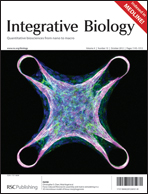In vitro reproduction of endochondral ossification using a 3D mesenchymal stem cell construct
Abstract
Endochondral ossification is one of the essential bone development processes in vertebrates. Although researchers from a variety of fields, including cellular/molecular biology, chemistry, and materials science, have worked to gain a better understanding of the tissue development, integration of findings from these different fields remains a major challenge. An in vitro model system that reproduces endochondral ossification would be a valuable tool for overcoming this problem, because an in vitro standardized model system can be easily accessed by researchers from different fields. Here, we fabricated a large 3D mesenchymal stem cell (MSC) construct with a ball-like morphology, which is termed a cell ball, and cultured it under a hypoxia condition, since hypoxia causes chondrogenic differentiation of MSCs in primordial cartilage, which is crucial for endochondral ossification. Region-specific chondrogenic differentiation of MSCs and mineralization within the cartilage tissue were observed in the cell ball. The precipitated


 Please wait while we load your content...
Please wait while we load your content...